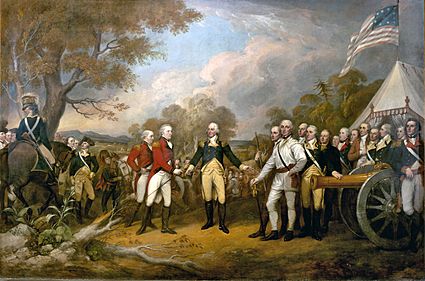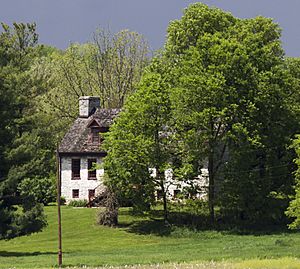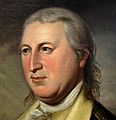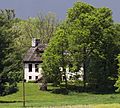Horatio Gates facts for kids
Quick facts for kids
Horatio Gates
|
|
|---|---|
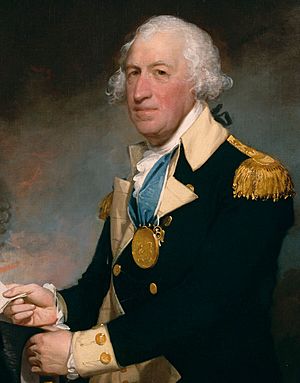
Gates in a c. 1794 portrait by Gilbert Stuart, on display at the Metropolitan Museum of Art
|
|
| Born | July 26, 1727 Maldon, Essex, Great Britain |
| Died | April 10, 1806 (aged 78) New York City, U.S. |
| Buried | |
| Allegiance | Great Britain United States |
| Service/ |
British Army Continental Army |
| Years of service | 1745–1769 1775–1783 |
| Rank | Major (Great Britain) Major general (United States) |
| Commands held | Continental Army
|
| Battles/wars | War of the Austrian Succession Seven Years' War American Revolutionary War |
| Relations | Thomas Gates (great grandfather) |
| Signature | |
Horatio Lloyd Gates (born July 26, 1727 – died April 10, 1806) was an army officer. He was born in Britain but became an American general. He served in the Continental Army during the American Revolutionary War.
Gates is known for his role in the Battle of Saratoga in 1777. The Americans won this important battle. However, he was also blamed for a big defeat at the Battle of Camden in 1780. Some people consider him a controversial figure. This is because of his disagreements with George Washington and his actions in these key battles.
Horatio Gates was born in Maldon, England. He first served in the British Army. He fought in the War of the Austrian Succession and the French and Indian War. He later moved to Virginia in America. When the Revolutionary War began, he joined the Continental Army. George Washington recommended him for a top job.
Gates became the Adjutant General in 1775. He later commanded the Northern Department. His troops won the Battles of Saratoga. After this victory, some leaders thought about making him the main commander. But Washington remained in charge. Gates later commanded the Southern Department. However, a major loss at Camden ended his military career. After the war, he freed his slaves and moved to New York. He died in 1806.
Contents
Early Life and Military Start
Horatio Gates was born on July 26, 1727, in Maldon, England. His parents were Robert and Dorothea Gates. His mother had important connections. She worked for powerful dukes. These connections helped young Horatio get a good education. They also helped him advance in society.
In 1745, Gates joined the army. His parents helped him get a military job. He served in Germany during the War of the Austrian Succession. Later, he went to Halifax, Nova Scotia. He fought in battles against the Mi'kmaq people and Acadians. In 1754, he married Elizabeth Philipps. He then bought a captain's position in New York.
Military Career and Key Battles
Serving in the Seven Years' War
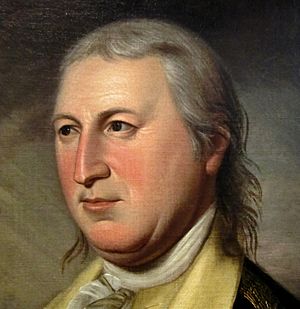
During the French and Indian War, Gates served General Edward Braddock. In 1755, he joined Braddock's expedition. This group tried to control the Ohio Valley. Other future American leaders were also there. These included George Washington and Charles Lee. Gates was injured early on. He did not see much combat.
He became good at military administration. In 1759, he was made a brigade major. This meant he helped manage a brigade. He served under General Robert Monckton. Gates helped capture Martinique in 1762. He brought news of this victory to England. This earned him a promotion to major. After the war, his chances for promotion ended. He did not have enough money to buy higher ranks.
In 1769, Gates sold his army position. He moved to North America. In 1772, he reconnected with George Washington. The next year, he bought a small farm in Virginia.
Joining the American Revolution
When the American Revolutionary War began in 1775, Gates offered his help. He went to Mount Vernon to meet Washington. In June 1775, Congress was forming the Continental Army. Washington suggested Gates become the army's adjutant. On June 17, 1775, Gates became a brigadier general. He was also the first Adjutant General of the United States Army.
Gates had valuable experience. He helped create the army's record system. He also helped organize the different colonial regiments. During the siege of Boston, he advised caution. He thought some plans were too risky.
Gates wanted a field command. In June 1776, he became a major general. He took command of the Canadian Department. This army unit was retreating from Quebec. Many soldiers were sick with smallpox. They also had low morale. Gates then had a disagreement with General Philip Schuyler. Schuyler commanded the Northern Department. Gates was given command of Fort Ticonderoga.
Gates spent the summer of 1776 building up the American fleet. This fleet was needed to control Lake Champlain. Benedict Arnold helped a lot with this work. Arnold commanded the fleet. The American fleet lost the Battle of Valcour Island. But their defense delayed the British attack until 1777.
Victory at Saratoga
In 1776, the British did not attack Ticonderoga. Gates marched some troops south. They joined Washington's army in Pennsylvania. Gates did not join Washington's attack at the Battle of Trenton. He thought Washington should retreat. Instead, he went to Baltimore. There, he tried to convince Congress to make him commander. But Washington's wins at Trenton and Princeton secured his position. Gates was sent back north to help Schuyler.
In 1777, Congress blamed Schuyler for losing Fort Ticonderoga. On August 4, Gates was given command of the Northern Department.
Gates took command on August 19. He led the army against British General John Burgoyne. This led to the Battle of Saratoga. Gates and his supporters took credit for the victory. However, other commanders were key. These included Benedict Arnold and Daniel Morgan. Arnold bravely led attacks against British lines. He was seriously injured. John Stark also defeated a large British force. This happened at the Battle of Bennington. These actions were very important for the American win.
A famous painting shows Gates at the surrender of Burgoyne. It hangs in the U.S. Capitol Rotunda. Congress gave Gates a gold medal. This was to celebrate his victories.
Disagreement with Washington
After Saratoga, Gates tried to gain more power. He sent reports directly to Congress. He did not send them to Washington. This was disrespectful to his commander. Some members of Congress wanted to replace Washington with Gates. Gates was even made president of the Board of War. This job made him Washington's civilian superior.
Washington learned about this plan. Gates's assistant, James Wilkinson, was involved. Gates later apologized to Washington. He resigned from the Board of War. In November 1778, he took command of the Eastern Department.
Defeat at Camden
In May 1780, the British captured Charleston, South Carolina. Congress then put Gates in charge of the Southern Department. He went south to take command. His forces were near the Deep River in North Carolina.
Gates led his troops to face British forces. These were led by Charles Cornwallis. The two armies met at the Battle of Camden on August 16. Gates's army was badly defeated. Nearly 1,000 men were captured. The army also lost its supplies and cannons. Gates had put his inexperienced militia against the strongest British troops. He also failed to plan a good retreat. Gates rode 170 miles in three days to escape.
His military reputation was ruined. His son Robert also died in combat that October. Nathanael Greene replaced Gates on December 3. Gates returned home to Virginia. He did not hold another command for the rest of the war.
Later Life and Legacy
Gates's wife Elizabeth died in 1783. He retired in 1784. He returned to his home, Traveller's Rest, in Virginia. He served as vice president of the Society of the Cincinnati. This was an organization for former Continental Army officers.
In 1786, Gates married Mary Valens. She was a wealthy woman from England. In 1790, Gates decided to free his slaves. He sold his plantation, Traveller's Rest. The sale agreement arranged for his slaves to gain their freedom. This was a significant step for the time.
Gates and his wife moved to an estate in New York City. He was elected to the New York State Legislature in 1800. He served one term. Horatio Gates died at his home on April 10, 1806. He was buried in the Trinity Church graveyard in New York City. The exact spot of his grave is not known.
Several places are named in Horatio Gates's honor. These include the town of Gates in New York. There is also Horatio Street in Manhattan. Gates Avenue runs through parts of Queens and Brooklyn. Gates County in North Carolina is also named after him. His home in York, Pennsylvania, is now called the Gen. Horatio Gates House.
Images for kids
-
Gates in a c. 1794 portrait by Gilbert Stuart, on display at the Metropolitan Museum of Art
-
General Gates as he appears at the National Portrait Gallery in Washington, D.C.
-
Surrender of General Burgoyne by John Trumbull
Gates is in the center, with arms outstretched
See also
 In Spanish: Horatio Gates para niños
In Spanish: Horatio Gates para niños


